What can not be fertilized with ash. The use of wood ash as a fertilizer
Not sure how to use wood ash on the site? In this article, we will describe in detail how to properly fertilize different cultures using ordinary ashes.
In an accessible form, wood ash contains about 30 minerals that are necessary for the proper development of plants. At the same time, there is no chlorine in such a valuable fertilizer, therefore, it is recommended to use ash to feed plants that react negatively to this element: strawberries, raspberries, currants, potatoes. Also, pumpkin, cabbage, beets, tomatoes and cucumbers respond well to the application of wood ash.
But keep in mind: plants that love acidic soil (for example, blueberries, cranberries, lingonberries, azaleas, camellias, rhododendrons) do not tolerate ash.
Ash is kiln (from burnt wood) and vegetable. Ash from firewood and logs, which are free of mold and various impurities from burning plastic film, synthetics, rubber, colored paper, etc., is considered environmentally friendly and suitable for use as a fertilizer. Of the tree species, potassium is most found in deciduous ash, especially birch. It is recommended to use it as fertilizer for the garden.
Valuable ash is also obtained by burning herbaceous plants such as sunflower and buckwheat. They contain up to 36% potassium oxide. And the least potassium and phosphorus in peat ash, but there is a lot of calcium.
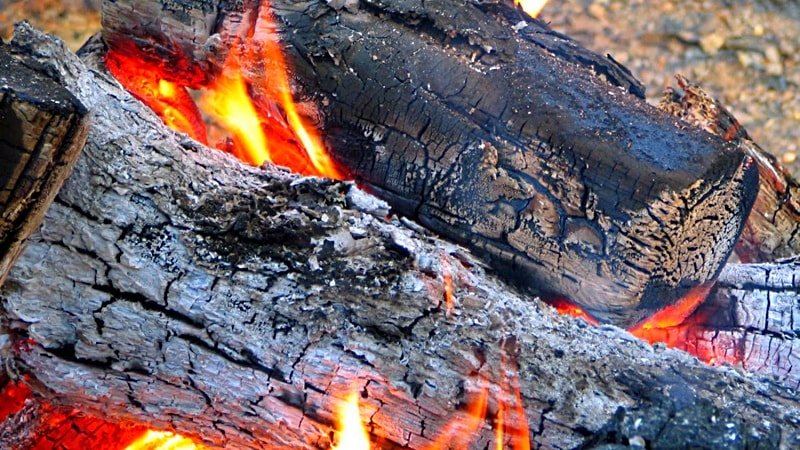
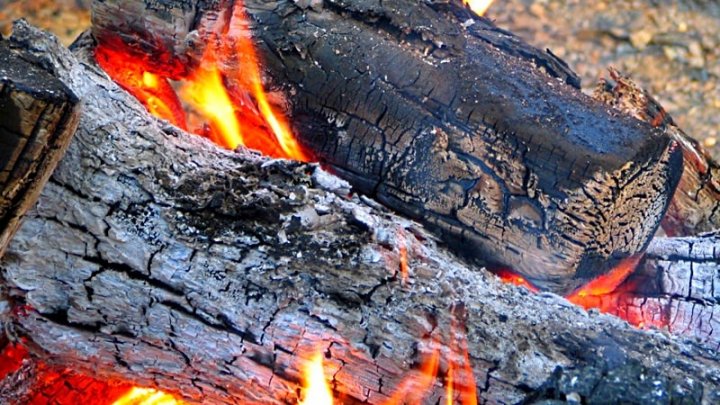
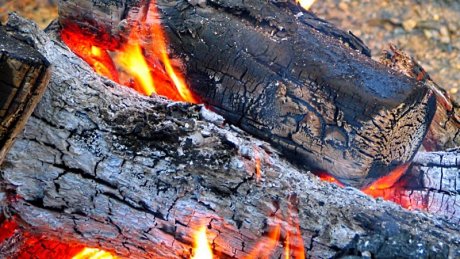
You can not feed wood ash obtained by burning household waste.
After burning wood or plants, ash is collected and stored in a dry place in a wooden box with a tight airtight lid. Plastic bags for storing ash are not suitable, since moisture condenses in them.
How much ash is contained in different containers
Wood ash is used in dry and liquid form. In the first case, the ash is simply embedded in the soil as fertilizer, and in the second case, ash infusions and solutions are prepared from it.
How to prepare a solution of ash
In order not to harm the plants, but to help them develop correctly, you need to know how to breed ash for feeding. This is not at all difficult to do: 1 glass of ash should be stirred in a bucket (10 l) of water. This liquid is usually watered plants under the root instead of industrial mineral fertilizers. Before use, the resulting solution must be thoroughly shaken, since a precipitate forms in it.
How to cook an infusion of ash
In order to prepare a fertilizer useful for plants, ash can be insisted. To do this, fill the 1/3 bucket with ash, fill it with hot water to the brim and insist for two days. After that, the infusion is filtered and used for root dressing or spraying of garden crops.
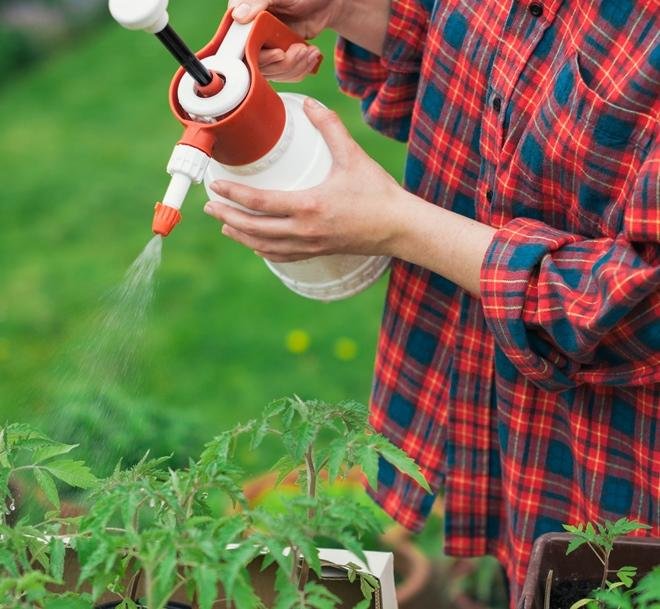

Foliar top dressing with ash
Foliar feeding can be carried out not only with infusion of ash, but also with broth. To do this, sift 300 g of ash, pour boiling water and boil for 25-30 minutes. After which the broth is cooled, filtered and diluted with 10 liters of water. To make fertilizing better stick to the leaves, you need to add 40-50 g of laundry soap to it.
Spraying with ash broth helps protect crops from diseases and pests, in particular from wireworms, aphids, cruciferous fleas, nematodes, slugs, snails.
The use of ash in the garden
When feeding vegetables with ash, the first thing to do is take into account the level of acidity of the soil. Alkaline soil is not fertilized with ash, because this will lead to even more alkalization. But the introduction of ash into acidic soil makes its reaction close to neutral.
Feeding seedlings with ash
To accelerate the growth of seedlings, it must be pollinated with a thin layer of ash every 8-10 days. This procedure will also protect plants from pests. When 2-3 real leaflets appear on the plants, they should be dusted with a mixture of ash and tobacco dust (in equal proportions). So you scare cabbage fly, cruciferous flea and other insects from seedlings.
Also, when transplanting seedlings into the ground, 1-2 tbsp. dry ash. Such top dressing will fertilize the soil and help plants to take root better.

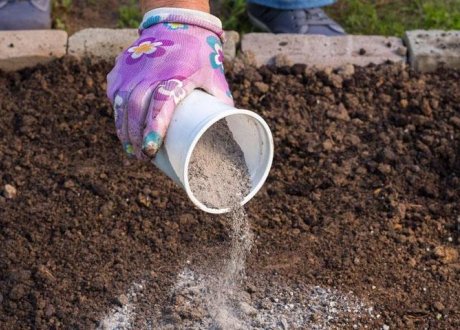
Feeding plants with ash in a greenhouse
An ash solution is most often used for watering vegetables (primarily cucumbers) grown in a greenhouse. In protected ground, root top dressing is usually carried out: 0.5-1 l of liquid ash fertilizer is consumed per plant.
Feeding cucumbers with ash
Cucumbers are especially deficient in potassium and calcium during the formation of ovaries. Therefore, in order to improve the ripening of the fruits, at the beginning of flowering, plants are watered with infusion of ash (0.5 l for each bush). Top dressing is repeated every 10 days.
Cucumbers grown in the open ground are additionally fed with a foliar method: they are sprayed with an ash broth so that the entire leaf plate is covered with a gray coating. During the period of active growth and budding, 3-4 feedings per month are carried out.
Topping ash tomato and peppers
When growing tomatoes and peppers while digging the soil, 3 cups of ash per 1 sq. M are brought in, and when planting seedlings of these crops, a handful in each hole. Also, ash can be applied under peppers and tomatoes throughout the growing season. Before each watering, the soil under the bushes is sprinkled with ash, and after wetting, the soil is loosened.
Feeding with onion and garlic ash
For onions and garlic during autumn digging, 2 cups of ash per square meter are brought into the soil, and in the spring - 1 cup per square meter. These crops are prone to root rot, and the introduction of wood ash into the ground prevents the growth of putrefactive bacteria.
Also, onions and garlic can be fed with infusion of ash under the root or water them with grooves. But this is done no more than three times per season.
Feeding potatoes with ash
When planting potatoes, 2 tablespoons are made under the tuber in each well. ashes. When digging the soil, apply 1 glass of ash per sq.m. During the growing season, at the first hilling of potatoes, 1-2 tablespoons are made under each bush. ash, and at the second hilling (at the beginning of budding), the rate is increased to 1/2 cup under the bush. It is also useful to spray potatoes on leaves with an ash broth.
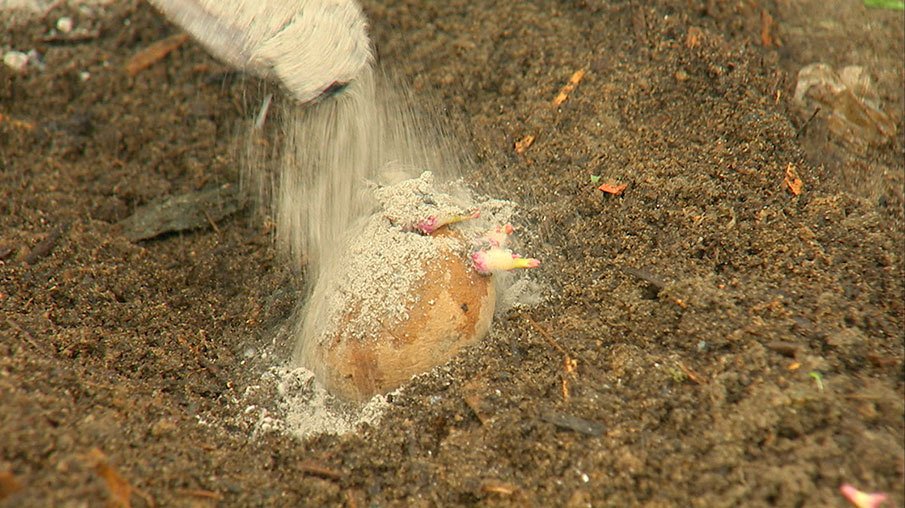
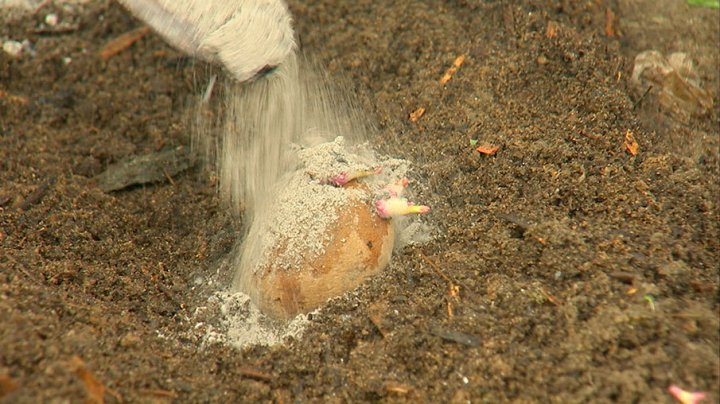
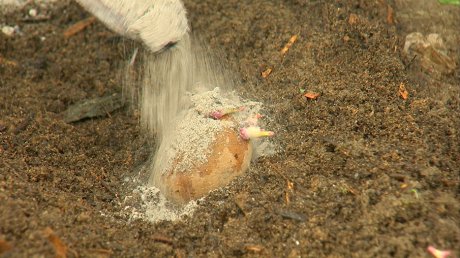
Feeding cabbage with ash
When digging cabbage of different types, 1-2 cups of ash per square meter are made during digging, and when planting seedlings - a handful in each hole. And ash perfectly protects representatives of the Cruciferous family from pests: plants are sprayed with infusion on the leaves. The number of treatments depends on weather conditions: if it rains, the leaves need to be pollinated more often.
Feeding with ash carrots and beets
Before sowing these crops, 1 glass of ash per sq.m. After emergence, it is necessary to sprinkle ash with carrot and beet beds once a week before watering the plants.
Feeding zucchini with ash
Under the zucchini make 1 glass of ash per 1 sq. M during digging the soil, 1-2 tbsp. - in each hole when planting seedlings, and on depleted soils during the growing season they additionally fertilize plants during irrigation: use 1 glass of ash per sq.m.
The use of ash in the garden
With the help of wood ash, you can protect trees and shrubs from diseases and pests, such as powdery mildew, bud mites, moths, cherry sawflies, etc. For this, the plants are sprayed with decoction prepared according to the same recipe as for foliar top dressing of vegetables. Do it in the evening in calm weather.
Ash is also good as a fertilizer that stimulates the growth of plants and improves their immunity.
Straw top dressing with ash
Strawberries (garden strawberries) are sprinkled with sifted ash at the rate of 10-15 g per bush immediately after flowering. This prevents the spread of gray rot. If this procedure has to be repeated, then the ashes spend half as much.
Garden strawberries, fed with ash fertilizer, gives a greater number of peduncles and, accordingly, berries.


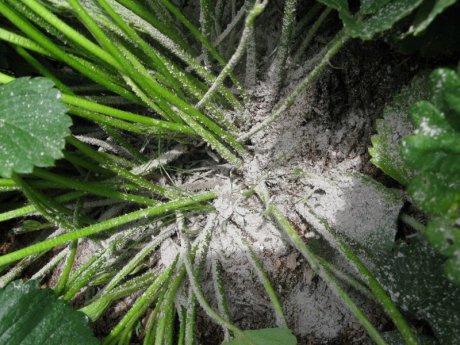
Topping grapes with ash
Grapes are fed 3-4 times per season: ash leaves are sprayed onto the leaves of plants after sunset. In this case, it is necessary to ensure that all sheet plates are coated with it evenly.
However, the vines themselves can be a good top dressing. In the autumn after the end of fruiting, all trimmed shoots (they must be absolutely healthy) are burned. The resulting ash (1 kg) is poured with 3 buckets of water and allowed to infuse. The resulting product is stored in a cool place for no longer than a month, periodically mixing. Before use, the infusion is diluted with water in a ratio of 1: 5 and chips of laundry soap are added there.
Feeding ash trees and bushes
When planting seedlings of fruit trees and shrubs in the soil to a depth of 8-10 cm, 100-150 g of ash per 1 sq.m are covered. Such top dressing contributes to the rapid adaptation of plants to new conditions and the early development of the root system.
Adult trees and shrubs are fed with ash every 4 years: about 2 kg of ash are brought into each trunk circle.
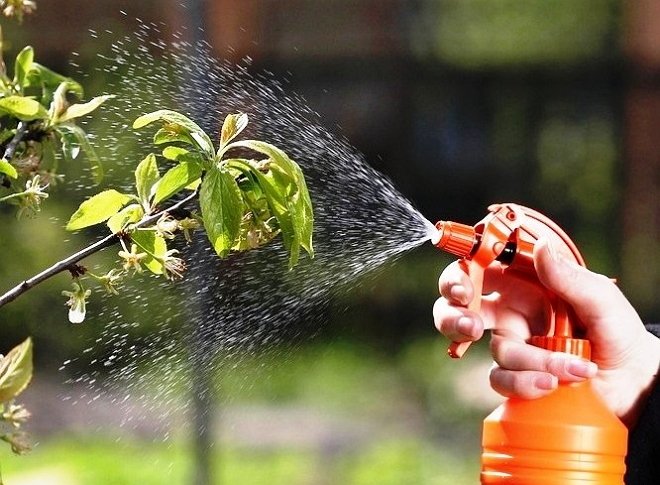
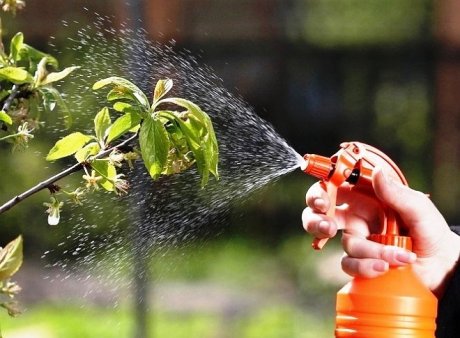
Feeding flowers with ash
Fertilizer from ash is especially useful for roses, lilies, clematis, gladioli and peonies. When planting seedlings of flower crops, 5-10 g of ash are laid out in each well.
Flowers that have been attacked by pests are evenly dusted with infusion of ash (with the addition of soap). Do this in the morning in calm weather through dew or after rain. During drought, plants can be sprayed with water at room temperature before treatment.
Now you know how to prepare top dressing from ash and how to use it correctly in the garden, orchard and flower garden. This organic fertilizer is not only useful for plants, but also safe for people and pets.
Wood ash as a fertilizer has been used for a long time. This substance is rich in various trace elements necessary for plant growth. Let's figure out how to properly apply ashes on the site.
Wood ash is a low-cost and affordable option for fertilizer, which contains about 30 minerals necessary for the proper development of plants. It neutralizes the acidity of the soil and makes garden crops unattractive to pests. In addition, ash positively affects the air permeability of the soil - makes the earth more loose, which contributes to the development of the root system of plants.
Wood ash is a natural mineral fertilizer based on organic matter.
Wood Ash Composition
Depending on the type and age of the plant that is burned, the composition of the ash varies. But there is a general formula derived by Mendeleev, from which you can find out the approximate percentage ratio of substances contained in 100 g of ash.
As you can see, the composition of the ash includes elements useful for plants, such as calcium, potassium, sodium and magnesium. Without them, our green pets will not be able to fully develop and bear fruit.
So, calcium carbonate improves metabolic processes and accelerates the growth of vegetative tissues. This substance is especially important for flowering plants, as it contributes to a more magnificent flowering.
Calcium silicate "sticks together" plant cells and helps the green body absorb vitamins. Onions react very sharply to the deficiency of this compound: the bulbs of such plants exfoliate and dry out.
Calcium sulphate - It is a calcium salt of sulfuric acid, which is part of such a popular fertilizer as superphosphate.
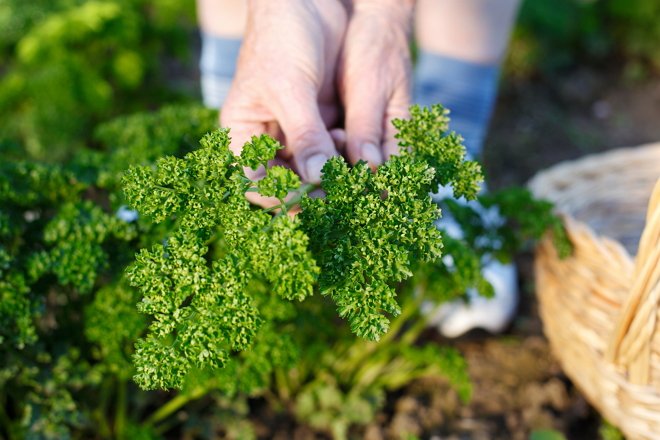
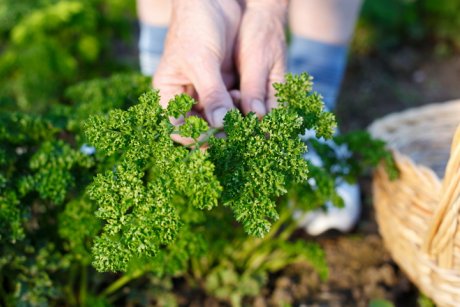
Calcium chloride - A necessary element for fruit and vegetable crops (especially cucumbers, pumpkins and zucchini). It promotes the formation of enzymes, participates in photosynthesis, helps transport nutrients, increases the winter hardiness of plants and their immunity to many dangerous diseases (in particular, to rot), and also maintains the uniformity of the soil.
Potassium Orthophosphate Helps regulate plant water balance. With a deficiency of this substance, ammonia accumulates in the leaves and roots, which inhibits the growth of plants. And this substance also helps to increase the winter hardiness of heat-loving crops and creates a favorable alkaline environment for roses, lilies and chrysanthemums.
Magnesium compounds Along with potassium, they participate in the production of energy by the plant, in the formation of carbohydrates, which become the building material for starch and cellulose.
Sodium compounds (sodium orthophosphate and sodium chloride) improve the water balance of plants and activate their enzymes. Sodium is especially needed for tomatoes.
Excess micronutrients in the soil are as harmful to plants as their deficiency. Therefore, wood ash should not be used if crops suffer from excess calcium or potassium. This can be determined by the excessive growth of leaf rosettes, the death of shoots along the entire length, browning of the fruit, premature fall of the leaves, as well as a change in their color (they turn white).
How to collect ash?
Ash happens stove (from burnt firewood) and vegetable. The first one is just gently taken out of the oven, and for cooking the second one needs a special device. You can use a metal box (preferably with a lid and a tray). At the same time, holes must be made in the bottom of the container through which ash will spill out into the pan.
Any plant debris is burned in a box: tree branches, hay, straw, tops, weeds. But for this purpose it is better not to use trees that have grown near highways: such ash will contain a lot of lead and other heavy metals. Also, ash cannot be used as a fertilizer after burning polymers, household waste, rubber, glossy magazines, colored paper and synthetic materials. Such ashes will not fertilize, but poison the soil in the garden.
The ash produced by burning hardwood contains more potassium. And ash from coniferous species - more phosphorus.


What plants and how to fertilize with wood ash?
Some plants especially like wood ash. Therefore, it is quite capable of replacing chemical fertilizers.
- Under cucumbers, zucchini and squash make 1 glass of ash during the digging of the soil, 1-2 tbsp. in each hole when planting seedlings, and on depleted soils during the growing season they additionally fertilize plants during irrigation: use 1 glass of ash per sq.m.
- Under tomatoes, peppers and eggplant during the digging of the soil, 3 glasses of ash per square meter are brought in, and when planting seedlings of these crops, a handful per hole.
- Under different types of cabbage when digging, they add 1-2 glasses of ash per square meter, when planting seedlings - also a handful in the hole.
- Under bow and winter garlic during autumn digging, 2 cups of ash per square meter are brought into the soil, and in the spring (as fertilizer) - 1 cup per square meter.
- Before sowing peas, beans, lettuce, watercress, radish, dill, carrots, parsley, radish and beetroot 1 glass of ash per 1 sq.m.
- When landing potato 2 matchboxes of ash are mixed with the ground and placed under the tuber in each well. In the spring during digging, apply 1 glass of ash per sq.m. During the growing season, wood ash is also used as top dressing: during the first hilling of potatoes, 1-2 tablespoons are made under each bush. ash, and at the second hilling (at the beginning of budding), the rate is increased to 1/2 cup under the bush.
In order for potatoes and garlic to be better stored in the winter, you can sprinkle them with sifted ash. So you provide them with additional protection against decay.
- Grape they are fed several times a season: in the evening, an infusion of ash is sprayed on the leaves of plants (1 kg of fertilizer is dissolved in 3 buckets of water, and before use it is additionally diluted with water in a ratio of 1: 5).
- When growing roses wood ash is introduced during the autumn digging to normalize the acidity of the soil. From the second year, roses are fed in the spring (100 g per 10 liters of water). Foliar top dressing is also used: infusion prepared from 200 g of ash and 10 l of water is sprayed on the leaves of plants.
- When landing seedlings in the pit, you can add up to 1 kg of ash mixed with earth (under fruit trees), up to 500 g - under berry shrubs.
- When growing seedlingsTo reduce the acidity of the soil, ash can also be added. The amount is calculated individually, depending on what kind of land you used when preparing the soil, and what plants you plan to sow. But the average proportion is 1 glass of ash per bucket of earth.
- Some gardeners contribute ash to near-tree circles of trees and shrubs for digging every two to three years. And gardeners alternate the feeding of vegetables with the help of organic fertilizers and ash infusion under the root in the proportion of 1 glass of ash per bucket of water.
Some gardeners use ash infusion as an organic stimulant to help seeds germinate. For this, seeds are wrapped in a piece of cloth moistened with ash solution and left for several hours. In the future, they are dried and sown.

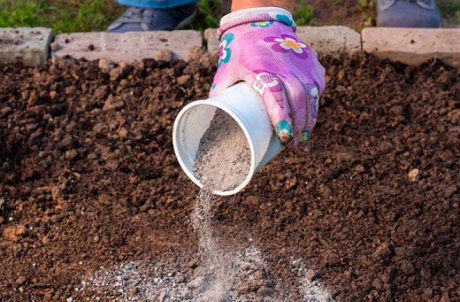
Ash slightly reduces the acidity of compost, creates favorable conditions for the development of beneficial microorganisms and the work of earthworms.
The use of ash on different types of soils
Wood ash does not fertilize soils with a high alkali content, as ash alkalizes the earth. In such a soil, plants cannot develop properly. And when wood ash is introduced into acidic soils, on the contrary, their reaction becomes neutral, which creates favorable conditions for crops.
The only exceptions are plants that initially prefer acidic soil (radishes, melons). Therefore, they need to be fed with ash with caution to prevent alkalization of the soil.
On sandy soils, ash is applied only in the spring, and on heavier soils it can also be used for autumn digging. On loamy and clay soils, it is enough to add only 300-500 g of ash per 1 sq. M - this will improve the fertility and structure of the earth. And even after a single application of such fertilizer, the positive effect can last up to 4 years.
Ash as a pest control
Wood ash is not only an excellent fertilizer, but also an effective means of combating fungal diseases (in particular) and insects that damage garden and garden crops.
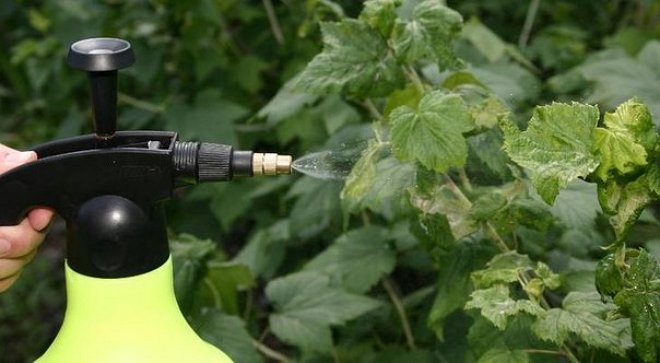
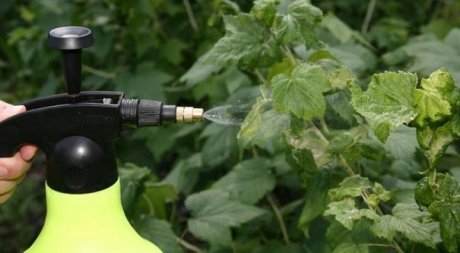
When 2-3 real leaflets appear on cabbage, radish, radish and rutabaga, the plants are dusted with a mixture of ash and tobacco dust (in equal proportions). This will protect vegetables from cabbage flies and cruciferous fleas.
Before planting in the soil, potatoes are dusted at the rate of 1 kg of ash per 30-40 kg of tubers. After such a procedure, the potato becomes unattractive to. And many gardeners note that regular addition of ash to the earth helps to exterminate.
Powder dusting of carrots, feathers of onions and shoots of cabbage, radish and other cruciferous trees with wood ash helps to fight carrot and onion flies, as well as cruciferous flea. Treatment of cabbage leaves with sifted ash dissolved in water (1 glass of ash per bucket of warm water), according to some gardeners, also reduces damage from caterpillars.
Ash infusion is effective when used in the fight against. It is prepared simply: 12 l of cold water, 110 g of laundry soap and ash, 20 g of urea are thoroughly mixed and insisted for 2 days.
To protect strawberries (garden strawberries) from gray rot, during the ripening period of the berries, you can sprinkle plants with ash (2 tablespoons per bush).
Gardeners and gardeners ash is used as a mineral fertilizer. It is popular among lovers of natural gifts of nature, seeing the negative impact on human health of various chemical growth accelerators and means to increase productivity. Suffice it to say that the ash contains trace elements in the form that is most suitable for assimilation by plants. Potassium, manganese, phosphorus, calcium in optimal proportions are in the ash obtained by burning straw. But not only this raw material is used for the production of natural fertilizer. If straw is not available, then use firewood of coniferous or deciduous trees, birch.
Why feed garden crops with ash? What is its benefit for cultivated plants? What diseases are fought with ash and which pests are afraid of it? We have to deal with these and other issues.
Ash as a stimulant in preparing seeds for planting
Having prepared an infusion of straw or wood ash, you can get a liquid with minerals dissolved in it. To do this, 2 tablespoons are soaked in a liter of water and left to infuse for 2 days. After that, the solution is filtered and used to soak the seeds (they are left in the infusion for 3-6 hours, then removed and dried) and feeding seedlings, or indoor plants.
Ash as a fertilizer
Ash is applied to all plants except carrots. Her plantings are very demanding on the soil, and such fertilizer will be superfluous for them. An infusion is prepared from the ash, and then they watered the earth around the plants or sprayed them. You can add ash directly to the soil by digging it to a shallow depth.

Ash for onions. Ash is used to feed the culture.
Ash for eggplant and pepper. Ash is added to the soil mixture for seedlings, the role of organic fertilizing is assigned to it. In addition, in cool and rainy summers, peppers and eggplant become sensitive to a lack of potassium and require fertilizer with the content of this trace element. Ash is scattered under the plants at the rate of 2 cups per 1 square. m
Ash for shrubs and fruit trees. Before planting a tree or a berry bush, a kilogram of ash is poured into the bottom of the planting pit. This is necessary in order for plants to quickly settle in a new place and better develop the root system. It is also recommended to periodically apply fertilizer to the trunks, for this every 4 years a shallow groove is dug around a tree, a couple of kilograms of ash is poured into it and crushed on top with soil.
Ash for cabbage. Ash is necessary for growing seedlings and when planting it in open ground.
Ash for turnips. Before planting seeds into the ground, prepared grooves are sprinkled with wood ash. The same technique is used when seedlings appear, they are powdered from above. Since ash is an optimal fertilizer for this crop, one must not forget to add it later, having dissolved a glass in a bucket of water. Plants are watered with infusion 2 times a month.
Ash for tomatoes. Seedlings of tomatoes will develop faster if you periodically water it with an ash solution. Planting plants in the ground is accompanied by the introduction of fertilizer (2 tbsp. Tablespoons) in each well.
Ash for strawberries. Ashes are fed in early spring. You can use dry fertilizer, it is planted in the ground around the bushes. This procedure helps to increase the number of peduncles, and, as a result, increase the yield. Ash is necessary for the formation of a new bed of berries, it is brought into the holes.
Ash for cucumbers. Planting cucumbers, a glass of ash is added to each hole. This fertilizer is part of many top dressings for vegetables.
Ash for radish. Potassium deficiency in the soil negatively affects the formation of root crops. Before sowing radishes, grooves are sprinkled with dry ash.
Ash for potatoes. Dusting seed potato tubers with ash contributes to the growth of lashes and increase productivity. In addition, potatoes from this procedure become more starchy.
It is not difficult to speed up the process of decomposition of organic waste: to do this, add ash to the compost heap, periodically pouring layers on it or pour compost with ash infusion. Such a fertilizer perfectly saturates humus with minerals and microelements and serves to create warm beds.

Ash as a means of controlling pests and diseases
Ash is an effective means of combating harmful insects and microorganisms. With its help, gardeners save seedlings from the so-called black legs, prevent powdery mildew on cucumbers and gooseberries, eliminate slugs and caterpillars on cabbage. Ash has a detrimental effect on gray rot, which affects strawberries, and keel, which is found on cabbage plantings.
Blight on tomatoes is better to prevent than to treat. For this purpose, about a week after the seedlings are planted on an open bed, the soil around the plants is treated with ash. Do not miss the appearance of the first ovaries, the same procedure is done during this period.
Cabbage aphid is afraid of a decoction of ash. It differs from the infusion in that it needs to be boiled (300 g of ash are diluted in a liter of water and boiled for 20 minutes). After cooling and settling, the liquid is filtered, water is added to obtain a volume of 10 liters and used to spray plants.
Caterpillars on cabbage are poisoned with ash infusion, its preparation must be done the night before. To do this, a glass of ash is mixed with a liter of water and left to infuse overnight. In the morning, the solution is shaken, filtered and used as directed. Cabbage leaves are treated on both sides and always in the early morning, when the caterpillars have not yet managed to hide.
The cruciferous flea will not annoy if the first seedlings of plants are dusted with ash in its pure form or mixed with tobacco dust. The disadvantage of this method is that it must be repeated after every rain or artificial irrigation.
Ashes scattered around garden crops will save you from annoying slugs. To prevent gray rot, planting strawberries is treated with ash immediately after flowering.
Ash broth or infusion of ash prevents the appearance of powdery mildew, affecting gooseberry bushes. To carry out prevention, the berry is sprayed 3 times, and water is added to the remaining sediment and the plants are watered under the root.
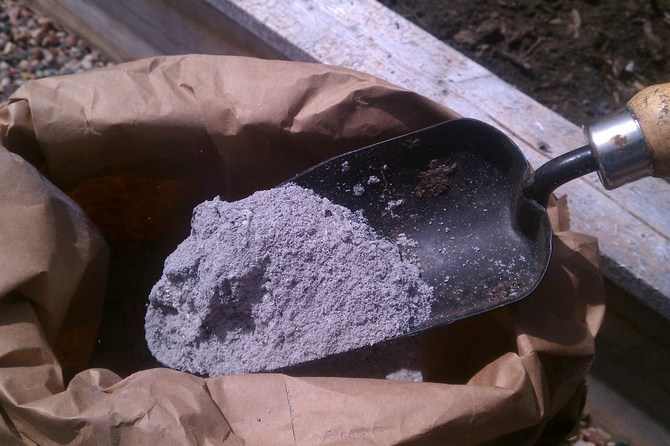
Using the antifungal and antiseptic properties of ash, you can save vegetables until spring. Ash powder needs to be processed root crops (beets, carrots, potatoes, celery, black radish) and put in boxes that put in a cool room. Garlic is preserved in a similar way, only ash will be needed more, the heads in the box are covered with it.
With increased acidity of the soil, lime is usually used. Using ash, you can also correct the situation and at the same time improve the structure of the soil, more safely. For practitioners of organic farming, it is useful to prepare an infusion, which includes ash. The component rich in microelements allows to receive excellent fertilizer.
Ash infusion is used to distill the onion onto the feather: the bulbs are kept in it for several hours before planting. Processing cuts and saw cuts on trees with ash powder will accelerate their healing. Mixing it with sawdust, get a mulch, which is sprinkled with tree shafts and beds.
Having a personal plot, it is difficult to do without ash. It replaces chemical fertilizers and acts only for the benefit of plants. Therefore, do not rush to take uprooted stumps and tree branches to the landfill after pruning, but adjust them to obtain irreplaceable fertilizer.
Do you add ash to the soil as fertilizer? If so, I want to puzzle you. The fact is that we have studied several stories about ash, and many people convince us that ash is an excellent fertilizer for plants.
Narratives because nowhere is it plainly said what happens in the soil with microorganisms, nematodes, fungi, worms when ash is added. We also want to deal with this. And even better - when and how much to throw ash, so as not to harm all living things!
Interesting conclusions were in the old book that each layer of compost should be sprinkled with ash. That this supposedly improves the habitat of worms and microorganisms. And also, which is very important, it will deoxidize compost. And who makes sour compost and how does it come about?
The acidity of the compost depends on the "mode" of the fermentation. Sour compost is obtained from anaerobic conditions. So change the conditions, do not press organics strongly, moderately water and periodically shift so that there is more oxygen in it.
And it’s better to observe the ratio - 1 part of nitrogen needs 25 parts of carbon when laying. Then you do not need to alkalize compost with ash and kill everything living there.
But recently we watched a video where a girl who seems to adhere to the principles of natural farming, pours almost a teaspoon of ash into a hole before planting seedlings of onion. And there the bare roots of the onion! There was no video about the crop ...
She wrote in the comments that there is never much ash, and that soil needs to be alkalized. But so many people watched this video, read the comments and believed!
Think for yourself. Ash is a caustic alkali. In old times it was used for washing clothes, because there were no powders. And with the help of ashes, things became so clean and white that no Persil was good for sucking!
So whom do we want to “wash” in the soil?
Yes, we used to think that ash is a good, environmentally friendly fertilizer. We understand that it is obtained from burnt firewood, branches, dry grass and leaves, but there is nothing to worry about. Not like synthetic fertilizers obtained in laboratory conditions, which are deposited in vegetables and fruits. Do not believe? Do a store tomato analysis.
So, in time we read the book of B.A.Bublik, where he talked about ash. That is not so good soil inhabitants in this caustic-alkaline environment. But really, we drive away slugs from plants with the help of ash. He poured a roller of ash around the plants and the slugs no longer crawl it. They move backwards, realizing that this will destroy them.
And how are slugs different from worms? The same delicate body secreted by mucus for better movement. Perhaps this tissue structure can be compared with the oral cavity. Pour ash into your mouth or eye, what will it be? But worms are a factory of humus, so necessary for good plant growth.
In the humus, where the worms were operating, there is a lot of soil nitrogen, potassium, phosphorus and other necessary trace elements, which already have a balanced state by natural, natural technology.
But worms will never take root on bare earth, and even sprinkled with ash. Do not burn organic matter in vain, it is better to mulch the soil with it. Then the worms will appear and create an excellent humus layer!
Therefore, we can summarize with worms. Ash destroys worms (as well as slugs) or simply makes the habitat uncomfortable. What do you choose?
A lifeless garden that requires ashes all the time, or a self-regulating natural system, where most of the time you will just relax and watch?
The situation is the same with soil microorganisms, hyphae of soil fungi and other smallest inhabitants of the earth. Gypsum mushrooms, binding for symbiosis with plants, play a very important role in transporting nutrients, secrete biostimulants, vitamins.
But even in my head it does not seem how soil fungi will develop normally in the earth when it is generously flavored with ash?
Where did this mania come from - fertilize the garden with ash? We can say that this was done by our grandparents, they did in the old days. How do you know that you always did this in the old days? Most likely, it was our great-grandmothers who didn’t fly ash without first finding out the acidity of the soil using folk methods.
And they began to pour on all different soils during the chemicalization of land, when some people realized that chemical fertilizers, pesticides, fungicides, insecticides could be promoted and sold first. To kill and so good soil! And then start selling all kinds of and even better chemical fertilizers, pesticides, lochocides ...
The rich immediately and lovingly destroyed all life in the earth, being proud and boasting that they supposedly did everything right, as it should be done by scientists. And for the middle peasants or those who simply did not want to spend money on chemistry, they colorfully told that ash is gray gold, it does not happen much, pour it everywhere and everywhere.
There will be no sores in plants, nor pests. We add from ourselves - and there will be no harvest! At least, after 5-10 years, when the turn comes to grandchildren and great-grandchildren, it feeds from this land.
Sprinkling the whole garden with ashes is akin to applying mineral fertilizers. Only ash is free. But this does not mean that she is gentle. That one, that the other falls into the soil and worsens the development of soil life. Which leads to land loss over time.
After all, the question is, why deliberately alkalize the soil? So that it is salted (lime prevails, the soil crackes, a crust is created and stony) and nothing grows on it? The situation is different with acidic soils, but more on that later. Just know that acidic soil is much easier to neutralize than alkaline soil.
Have you ever thought that in nature no one specifically burns organic matter in order to fertilize the soil? Or maybe you accidentally saw a squirrel with matches in the forest?
If a fire broke out in a forest or steppe, then this is a whole disaster for all living things. So why do we simulate a fire in our gardens? And are we not afraid to make soil not fertile with ash?
It is worth considering that when we burn organics, we lose the nitrogen we need for plants. What for? You can simply lay the same crushed organic matter in the beds.
It’s good if it’s some kind of baddle, grass, leaves. And how do you order to be with thick branches, logs, old and completely unsuitable boards?
Why is the warm bed bad? Put all the woody organic matter (mixed with green organic matter) in the beds and get the crop 1-2 weeks earlier! Would you be able to achieve this effect with ash?
Probably those who get ash from heating a house or a bathhouse would like to know how to be? Throw something ash at all? We ourselves periodically flood the house with firewood and about 2 bags of ash have already been collected. And you just need to use it wisely, having thought it over before, and not go around and “salt” the garden like borsch.
Be sure to first find out the acidity of your land. This can be done using folk methods or purchased indicator (litmus) paper. And it is advisable to check the land from different parts of the garden, because it may be that the garden under the slope and at the bottom of the soil is wetter, which means it can be more acidic.
If the soil is neutral, then most cultivated plants will feel good! But even such soil should simply be mulched to give it a lumpy structure, to grow worms (and this is humus) and to cultivate soil microorganisms and fungi - they will quickly process mulch (organic matter) and give the plants nutrition in an assimilable form.
If the soil is closer to alkaline, then it is not advisable to make ash at all. Otherwise, soon you will see salt deposits on the surface of the earth. Do you know that salts (stones) in the body can be deposited in humans?
Why then do this with the soil? Then the plants will accumulate these salts and be deposited in your body. So what should you do if the soil is alkaline?
The simple answer is to mulch and make compost (if you already have one and need to use it). Mulch is the home of worms and microorganisms, and thanks to them, the soil balance of Ph is restored.
But if you more believe a neighbor who, contrary to all logic, introduces ash into alkaline soil (they did this all her life), then you will soon worsen the soil structure, lime will prevail and plants simply will not be able to properly absorb the substances they need from soil solutions! And this is less than the harvest, the advent of pests and the emergence of diseases.
Remember, the effect of the introduced ash in the soil lasts for 2-4 years! And many people bring it there every year. A bucket of ash is in one hand, it is scattered around with the other and almost refrains: “I sow, I believe, I believe!”
We believe that ash can be brought into the soil, if the earth is quite acidic. They recommend 300-800 grams per square meter, depending on the acidity of the soil. Such soils also include swampy, sod-podzolic, marsh-podzolic and gray forest soils.
And then, it is advisable to bring ash to the garden in the fall! When all soil living creatures "fold and dig in for winter sleep." Then you will have less chance of harming worms and microorganisms.
During the winter and spring, the soil will be saturated with minerals that deoxidize it. And when constant warmth comes, and our garden assistants are activated, their living environment will even improve. The alkali from the ash will not be so caustic and Ph soil will improve.
Of course, the acidic, marshy land is the worst thing and it needs to be a little disturbed, help it with ash, so that later it comes to life. Because, for example, in acidic soil per 1 sq. M. about 25 individuals live in worms, and on pastures and meadows, where neutral soil is closer, 450 individuals worms per 1 sq. m.
And all you need is forbs with different root systems, structured land, cakes of cows (organic, mulch, compost, humus in our case) and no ash!
But in a secluded and shady place under the tree there was a party, they left a scorched place from the fire. What is growing there? And nothing will grow for another 2-5 years! Not because all the seeds burned there, because with the lightest breeze there will again come a bunch of seeds! But because there is strongly alkaline soil.
But if the earth is slightly acidic, so to speak, acidified, then just plant there those plants that feel good in such land.
Many people throw ash under potato tubers, but few people know that potatoes grow well on slightly acidic soil. Also on such land eggplants, zucchini, peas feel good ... But no, again we go with a bucket of ash and sow, winnow ...
And who brings ash under strawberries and raspberries when the soil is neutral? Well, try mulching part of the strawberries with peat or coniferous litter from the forest - what a fragrant strawberry it will be! Needles do not like slugs, and gray rot will be much less.
And plant a couple of raspberry bushes in a lowland where the soil remains moist for a long time (and therefore slightly acidified) - the berries will bend the branches to the bottom!
A bit of ash secrets.
Ash should not be mixed with nitrogen fertilizers - fresh manure, bird droppings, bean mulch or fresh compost. Most of the nitrogen is immediately lost and nitrogen fertilizers will have to be applied again. And compost in a heap or in a bed may simply not begin to ferment, because nitrogen is the “start” of organic fermentation.
If peat and ash are burnt, it is a sign of the predominance of iron in the ash. Such ash can not be introduced into the soil, since a lot of iron will not allow plants to absorb phosphorus normally.
And what does he like to “eat” iron? That's right, late blight on tomatoes and scab on potatoes. If the plants get sick like this, then plant mustard next to it, it will bind free iron in the soil and the plants will heal.
Ash can be introduced into the soil in a mixture with ripened compost and humus. Only when they are ripe!
After applying the ash, it is advisable to loosen the soil so that the ash falls under it. If you simply sprinkle ash on top of the soil, as is often done, to drive, for example, cabbage flea from young radish sprouts, then a crust will form on the ground. This crust prevents air permeability, which is harmful to both plants and soil living creatures.
Yes, this flea of \u200b\u200byour ash is not afraid! Just sow the radish from cabbage, mustard in a remote place, for example, in a greenhouse, greenhouse, or sow the radish after the cabbage flea has finished flying.
So in 2015, I sprinkled ash with radish, so it also bloomed quickly. And after dusting the leaves curled the next day and turned pale. After a couple of days, the flea also bit.
It turns out that ash affects the radish badly, its roots are tanned and color is thrown out. But this I only know about radishes, and maybe some other plants from ash - not so hot?
You see, if you don’t care what is there and you are already tired of the garden, constantly feeding plants, then you have lost a lot of things. First of all - children's interest and observation. Secondly, healthy food. Thirdly, money.
Your choice, but it’s never too late to get to know your land again and help it develop - while resting! And do not stubbornly violate natural laws and be at a loss.
The final result.
First we check the acidity of the soil, and then we decide whether to add ash or not.
It is necessary to bring in when the soil is acidified.
Ashes are best applied to the soil in the fall, when the earth has the smallest number of living organisms.
Ash and nitrogen fertilizers are incompatible.
To feed the plants in the garden, prefer not to rake the leaves and leaves in a pile once again, then burn them, then walk around and scatter the ash around ... and just lay the collected organic matter in the beds.
Ash is a caustic alkali and it creates adverse conditions for the life of worms, soil microorganisms, fungi, nematodes, algae, etc., that is, all that makes such an expensive humus!
Think a hundred times, observe nature, and then “chop”! And of course, experiment!)
References:
B.A.Bublik. "About the garden for the lean and lazy";
G.F.Raspopov. “Soil fungi in plant life”;
A.M. Igonin. "How to increase soil fertility tenfold using earthworms."
The author of the article is Julia Nekhaev, revised by Nikolai Nekhaev.
MAKE GOOD, SHARE this page in social. networks
In contact with
Thanks to the burning of wood, ash contains potassium, calcium, phosphorus and other trace elements: sulfur, boron, magnesium, which are so necessary for plants. In addition, plants will receive potassium and phosphorus from ash faster than enrichment with chemical fertilizers.
Ash is the cheapest and most affordable fertilizer for every gardener and gardener. In addition to enriching the soil and plants with minerals and other beneficial substances, it is a soil neutralizer. It is very useful to apply it in acidic soils, preferably carefully applied to strongly acidic soils. By the way, the ash does not contain nitrogen, since it evaporates during combustion.
Natural fertilizer is obtained by burning natural materials. Depending on whether straw, tree or vegetable tops are burned, ash of different value is obtained.
Ash obtained by burning plants
It is obtained by burning straw, dry grass and leaves. It contains a large amount of potassium.
The most useful for plants and soil fertilizer is “potato” ash, which is obtained by burning potato tops. As a result of burning, a dry dark powder remains, consisting of:
- potassium - 30 percent;
- calcium - 15 percent;
- phosphorus - 8 percent;
- many different trace elements.
It is also rich in potassium ash, which was obtained from burning dry buckwheat straw, as well as sunflower. And if you burn wheat and rye straw, you can get fertilizer, which will contain a maximum percentage of phosphorus - 6 percent.
Woody
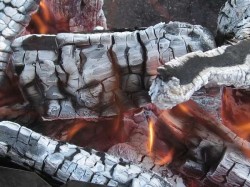
Get wood ash by burning strong wood.
Such a fertilizer will contain a large amount of potassium. But if you burn softwood: linden, alder, pine, aspen, you can get useful fertilizer, but with a lower percentage of potassium.
Separately, it is worth noting the unique properties of birch logs. Despite the fact that the tree belongs to a soft breed, as a result of the burning of logs, an excellent fertilizer is obtained, which is rich in potassium, calcium and phosphorus.
When choosing tree species, young trees should be preferred, since when burned, the ash will contain more potassium than the ash from an adult tree.
Coal
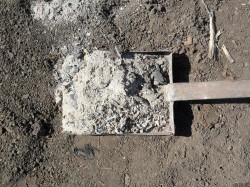
Despite the fact that the ash obtained by burning coal is not rich in potassium and phosphorus, it contains a large percentage of silicon oxide. Such ash should be used to loosen moist clay soil, as well as a substitute for sand, to improve the structure of the soil.
In addition to these positive properties, coal ash contains a large percentage of sulfur, which provokes the formation of sulfates. Thus, the resulting ash will be an acidifier of saline soil.
Apply ash obtained from coal, on neutral soil and slightly acidic. Together with it, bird droppings, manure and calcium nitrate are introduced into the soil. They make top dressing of the soil in such quantity: three kilograms of fertilizer are applied per one hundred square meters of land. This is done at the end of the season, when the average daily temperature is plus five degrees.
In addition, it is good to fertilize the soil with such ash for growing cabbage, onions and garlic, as well as horseradish and rutabaga.
The effect of ash on plants
Depending on what type of ash is introduced into the soil, you can get a good growth of various crops. Since chlorine is not present in the ash, it can be used for such plants:
- wild strawberries.
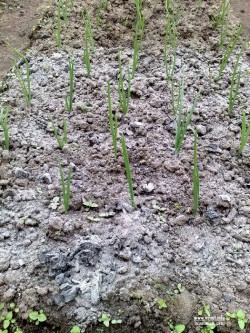
And if you fertilize the soil on which you plan to grow, then the ash will protect the plant from unpleasant diseases: keels and "black legs".
If you add just a couple of tablespoons of ash in the hole before planting zucchini, cucumbers or squash, you can get a good harvest. Also, when it is time to plant seedlings, pepper, eggplant, then three tablespoons of ash are added to the hole and thoroughly mixed with the ground. You can do it another way: when the garden is being dug up, then 750 grams (three glasses) of ash are applied per square meter.
Every lover of collecting a good crop from their beds knows that when the radish and cabbage form several standard leaves, it is advisable to dust them with dry ash. It is pre-mixed with tobacco dust in proportions one to one. Thus, it is possible to prevent infection of plants with cabbage fly and flea.
The dosage of ash for each plant is as follows:
- for winter, as well as for planting onions, in the fall, during digging, 500 ml of ash (two glasses) per square meter is applied. If it is planned to feed the earth, then one glass per square meter;
- before sowing peas, beans and, it is advisable to dig up the ground first by adding a glass of ash per square meter to it;
- for good growth of carrots and beets, you also need to add a glass of ash per square meter of land;
- to get a good potato crop, the soil is fertilized in the spring, directly during planting - two matchboxes in each hole, I mix the ash together with the ground. And during the earthing up of the plant, one - 12 grams of ash is added to each bush; at the next earthing up - the amount of ash is increased to half a glass for each bush.
In order not to get confused in the dosage of ash, which is purchased in the store, you need to know that in a tablespoon contains 6 grams, in a matchbox - 10, in a glass - 100 grams, and in a 0.5 jar - 250 grams.
How to make ash in a compost heap
It is undesirable to store ash on the street, under the sun and winds. Since ash dissolves in water, it should not be left outdoors in the rain. To preserve the nutrients in the ash, it is pre-mixed with the ground, this method is called "compost heap." They bring ash into the heap by pouring each layer of lawn grass (mowed), any weeds and food waste. Ash helps reduce acidity in the heap and creates good conditions for the reproduction of microorganisms and worms.
Ash use
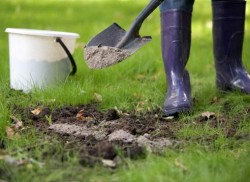
The wood zone obtained from straw, as well as coal ash is used not only for fertilizing the soil. She successfully fights early rotting vegetables. When vegetables (potatoes, carrots, beetroot) are stored in the basement for storage, it is more advisable to pour them abundantly with ash. If you plan to keep freshly cut flowers for a longer period, then the slices are also sprinkled with ash.
In addition, natural fertilizer contributes to the early germination of seeds, and also helps seedlings to become stronger. Most avid gardeners pre-soak the seeds before planting. For this, two tablespoons of ash are taken per liter of water, mixed. This mixture is infused for two days, and filtered before dressing. The infusion allows you to feed both seedlings and flower crops.
In order to increase the efficiency of wood as well as straw ash, it is used together with another fertilizer - humus or peat. For the mixture, one part of the ash is taken and mixed with two (or four) parts of humus or wet peat. With this mixture it will be convenient to distribute fertilizer throughout the garden.


